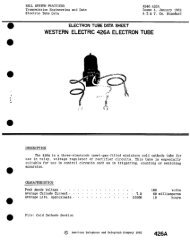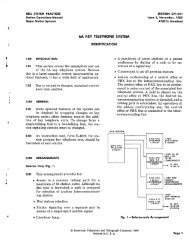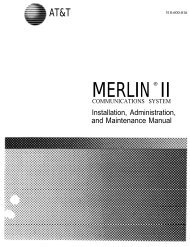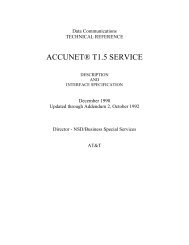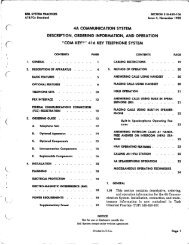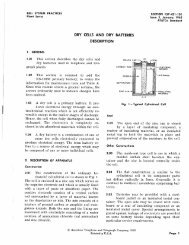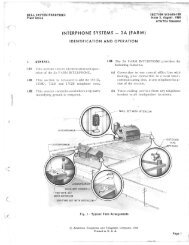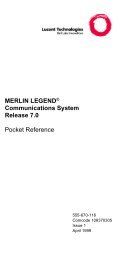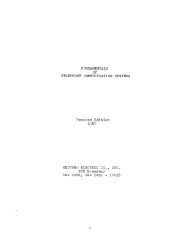COMMON LANGUAGE LOCATION IDENTIFICATION (CLLI) CODE ...
COMMON LANGUAGE LOCATION IDENTIFICATION (CLLI) CODE ...
COMMON LANGUAGE LOCATION IDENTIFICATION (CLLI) CODE ...
Create successful ePaper yourself
Turn your PDF publications into a flip-book with our unique Google optimized e-Paper software.
SECTION 795-100-100<br />
9. GENERAL GUIDELINES FOR ASSIGNING <strong>CLLI</strong> <strong>CODE</strong>S<br />
9.01 This Part includes a set of guidelines which<br />
provide a unified approach to development,<br />
administration, and maintenance of <strong>CLLI</strong> codes.<br />
Understanding <strong>CLLI</strong> code structure and applicability<br />
permits <strong>CLLI</strong> coordinators to ensure stability of<br />
codes and associated data in existing and future processes.<br />
9.02 The <strong>CLLI</strong> codes satisfy ongoing requirements<br />
for identification of locations and certain entities<br />
at those locations, and are applicable in any manual<br />
or mechanized system.<br />
<strong>CLLI</strong> codes should not be oriented toward a particu<br />
lar user. It is not the intent of the <strong>CLLI</strong> codes to iden<br />
tify each piece of equipment or each work group at a<br />
particular location. The <strong>CLLI</strong> code is not intended to<br />
describe attributes of the locations or entities being<br />
identified, therefore no attempt should be made to<br />
embed operational information in the code. When<br />
intelligence (meaning) is embedded in <strong>CLLI</strong> codes,<br />
those codes become increaingly difficult to adminis<br />
ter as the need for new code classifications develop.<br />
9.03 The code development and assignment process<br />
should include discussions with message<br />
trunk forecasting and transmission engineering<br />
groups. Code selection should consider future requirements<br />
as well as current application, with fu<br />
ture requirements having the higest priority.<br />
9.04 The code assignment process must include<br />
consideration of the needs of users of <strong>CLLI</strong><br />
codes, for instance, CLCI-MSG (Common Language<br />
Circuit Identification for Message Trunks) and CLFI<br />
(Common Language Facility Identification), since<br />
the <strong>CLLI</strong> codes are embedded in these circuit and facility<br />
identification codes.<br />
9.05 Due to widespread use of <strong>CLLI</strong> codes through-<br />
out the Bell System and in centrally developed<br />
systems, unnecessary code changes should be avoided.<br />
Obsolete <strong>CLLI</strong> codes should be removed from all<br />
data bases.<br />
Page 18<br />
9.06 Schemes which reserve characters or groups<br />
of characters within the elements of <strong>CLLI</strong><br />
codes should be avoided. Such schemes may lead to<br />
future encoding problems.<br />
Encoding Switching Entities-Guidelines<br />
9.07 Assignment of a <strong>CLLI</strong> code to identify an en<br />
tity is based on function of that entity at its<br />
assigned location. An entity may have many switching<br />
functions, and each function should be identified.<br />
Example: The following set of sample <strong>CLLI</strong><br />
switching entity codes has been developed to<br />
reflect the various functions and switching capabilities<br />
of a hypothetical central office comprised<br />
of:<br />
Foreign Exchange 922<br />
Tandem Switcher<br />
Switching Entity 233<br />
Switching Entity 232<br />
Sample codes:<br />
FUNCTIONS AND<br />
SWITCHING CAPABIUTIES <strong>CODE</strong><br />
922,233,232 combined to MG 1<br />
form Marker Group<br />
No. 1 (all units<br />
trunked together-less<br />
tandem)<br />
233,232 originating and 23A<br />
terminating locations<br />
922 foreign exchange 92A<br />
switcher<br />
Tandem -originating 01 T<br />
and terminating tan-<br />
dem traffic only<br />
233 and 232 plus tan- 2GT<br />
dem, grouped ( origi<br />
nating and terminat-<br />
ing)<br />
Terminating to 233 only 233<br />
Terminating to 232 only 232<br />
Terminating to foreign 922<br />
exchange switcher<br />
922<br />
CW FORMAT<br />
WXYZNJMAMGl<br />
WXYZNJMA23A<br />
WXYZNJMA92A<br />
WXYZNJMA01 T<br />
WXYZNJMA2GT<br />
WXYZNJMA233<br />
WXYZNJMA232<br />
WXYZNJMA922







